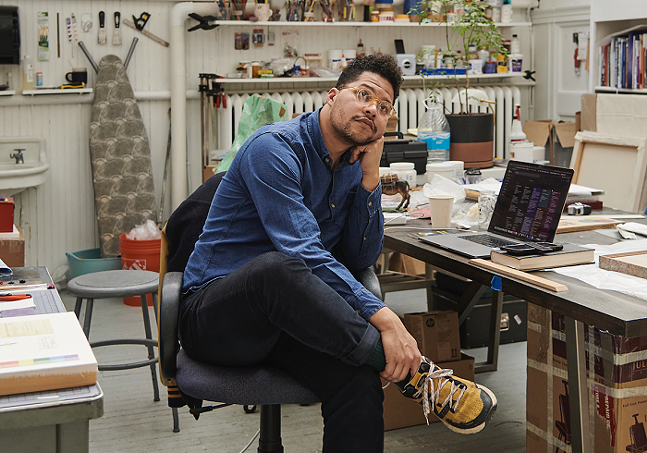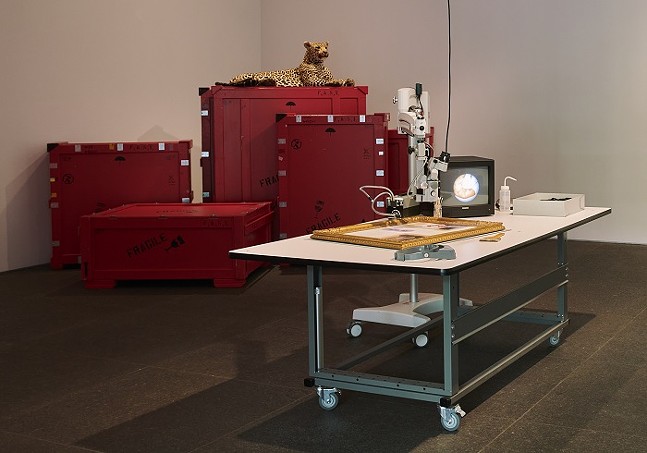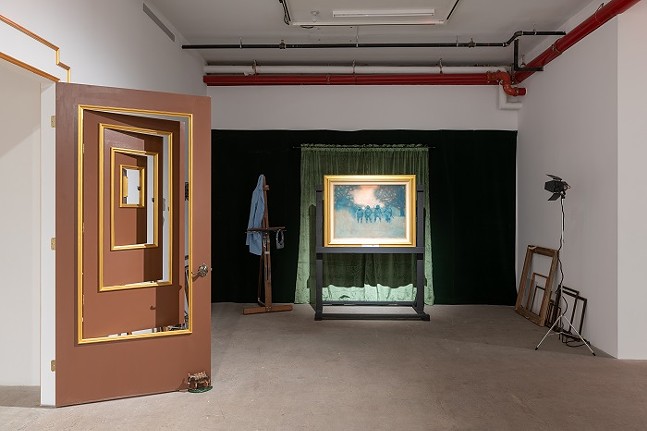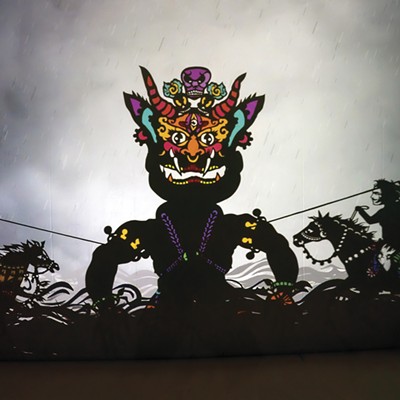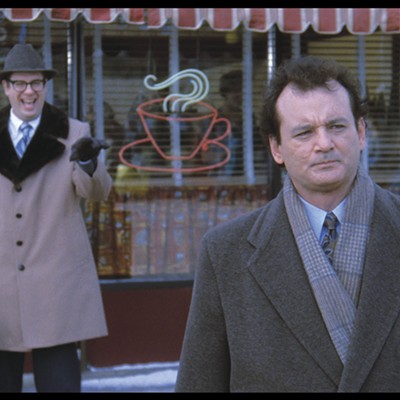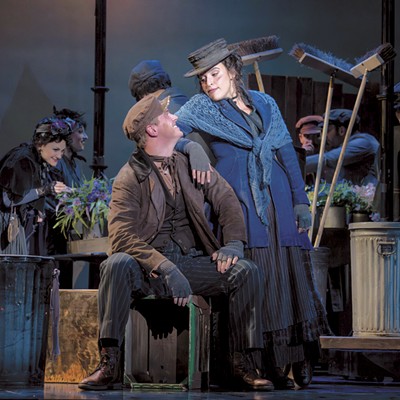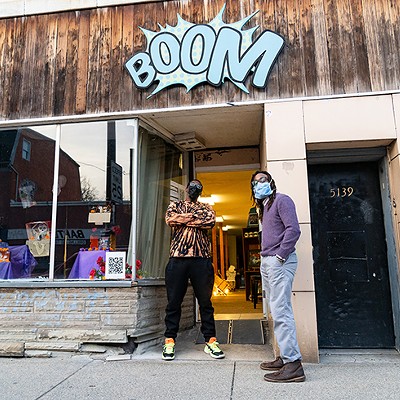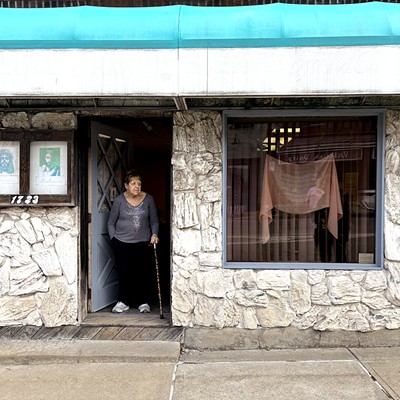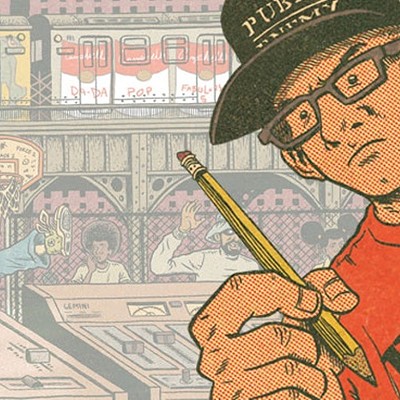An Art Nouveau-inspired painting titled “Kaleidoscope” comes with gold-lined ears and bold primary colors in an abstraction of shapes that resembles an elephant. There’s a leopard, borrowed from the adjoining Carnegie Museum of Natural History, perched on stacked crates. There’s a bookcase filled with real and fake crystals, artifacts, and other objects. In the center of the room is the empty working station of a questionable presence – a possible art forger.
With Rosette, on view at CMOA through Aug. 27, Pittsburgh-based artist Lyndon Barrois Jr. places museum-goers into the center of a space that nearly resembles a movie set, complete with a never-to-be-realized short script for a heist movie about museum conservators-turned-forgers. Barrois uses his solo show, featuring a whole new body of work, to consider an art movement influenced by stolen artifacts and defined by exploited labor. Even when silent, there’s another elephant presence with you in the room: the legacy of colonialism.
Pittsburgh City Paper spoke with Barrois about the origins of Rosette, the ways art is influenced by colonialism, and the complex idea of ownership in museums.
When did you start conceptualizing the show?
The story of the conservator-forger narrative is something that has been on my mind for almost 20 years. And originally, it was going to be just a full screenplay. It was after my own experience of taking a class on painting conservation. I was also really interested in crime fiction novels. At first, it was like, maybe it’s a novel or novella, and then I was like, no, I kind of see it, so maybe it should be a film. I've been thinking about it in the context of a film for a while, but the structure of that story and the character makeup has changed over time. Originally, the motivation to forge something was to protect it from a greedy inheritor, or someone who was going to inherit it and do something that the original owner didn't want to be done with it. So it was a sort of, like, protective strategy, to keep the real thing safe. And to allow a fake thing to travel in the world or through a market.
Later, I was reading more about the history between Belgium and the Congo, and things just kind of snapped into place, where I was like, this history feels like a good motivator. I'm interested in this history, I want to do something to speak to it.
The use of cinema in your art is recurring. Where does it originate, and why use cinema as a conduit for your message?
It lends itself to the production of physical things because there's already this way that stories allow objects to carry meaning. And also, I think, as a culture, the way that we consume film and television, you know, cinematic media, we're already accustomed to the language of marketing, and how these things are advertised to us and how we have a sense or a perception of a story before we actually we see the actual film. ... I've always kind of been interested in advertising and marketing strategies.And so, it was just sort of convenient that film production or the history of Hollywood marketing strategy has existing forms that I can play with or alter or rescale, and kind of translate into paintings or sculptures that also fit within or mimic the aesthetics of posters, lobby cards, film stills, physical props, you know, set environments. Playing with that, like the museum is a prop house. The museum has a collection. It’s a way of thinking of a museum collection as a sort of prop house. What can I borrow to assist the narrative I'm trying to tell?
To that point, many of these objects are borrowed. It’s a very meta and also somewhat sustainable choice. Can you talk about the process of choosing pieces to borrow and your goal in using borrowed pieces?
I feel like every visit we made a different, slight alteration or clarifying decision about what we wanted to do, which is really fun. And then once I got a sense of what objects I was using from the museum, then I could decide, okay, what do I need to make, to play off those things?Some things I already knew. I think I knew I wanted to make lobby card portraits. I knew I wanted to recreate at least two objects that I found buried in a Belgian institutional collection, which are the King Leopold II [work] and sculpture of two children playing. Both of these are definitely meant to reference rubber extraction and labor exploitation. This fragmented sculpture of children playing with their missing limbs was obviously a reference to punishment that people who were put to work in the Belgian Congo and who were amputated as a form of punishment, so I wanted to allude to those things without literally showing them.
There’s a lot of allusion here, and I really want to talk about the literal and figurative elephants in the room. Can you talk about the elephant, and unpack the symbolism?
This [elephant piece] was inspired by a series of essays by Debora Silverman called Art Nouveau: Art of Darkness. She is kind of making a case about these kinds of colonial roots within Belgian Art Nouveau, because a few of the more notable designers of this movement in that part of the world were affiliated with King Leopold, or commissioned by people within Leopold’s circle. So it's a combination of design works or elements from [Belgian painter Henry van de Velde] and [Belgian architect Victor Horta]. And there are other visual examples from different designs of theirs, either referencing something that she described as elephantine, or whip-like or vine-like to reference the rubber vines. It's also a different visual identity that they take on as distinct from different parts of the world. So yeah, just kind of trying to locate that visual lineage, and these designers, and how their relationship to these resources that were extracted by exploitational means were kind of embedded in their design sensibility.
There’s a tension here, between the desire to appreciate art through conservation and the potential harm done, that comes with keeping art in a way different than what the artist intended. Can you unpack that?
I was told by a conservator that there's an interesting shift between generations of artists, where, I would say, historically, in terms of hundreds of years ago, there was a sense of archival practice. And then we move into modern, post-modern [eras] to where people are making all these material experiments, and however the work is, whatever happens to it, they're okay with it degrading to a certain degree.But now, with contemporary art, I think we're interested in this weird thing of allowing something to decay or change up to a point, and then we want to freeze it there. And that's much harder to do. I think there's one part of a conversation in which value by colonial entities has been achieved by taking things, like resources, raw, natural resources, to fuel a particular economy.
There's also the case in which objects, like cultural artifacts, fetish objects, are taken from a place for their sort of exotic properties, and then, based on the new ownership, get assigned a particular value. Or even the way that something just simply being in a museum collection changes its value or changes its perceived value, which I guess I could say was also something that I've always been interested in, of using cheap materials presented well, or presented carefully, to hopefully change the perception of how it’s valued. I used a lot of cardboard in my work when I was an artist no one cared about. That was a highly critical aspect of my work. While at the same time, I could go to a museum and see a cardboard sculpture that is being so cared for.
So there are these kind of discrepancies as well. I'm also asking the question about aesthetic value. There's a bit of that in the script text as well. Like, if an object fulfills the same aesthetic experience as an original, does it matter whether or not it's fake? That’s just a question that I've always had ... at what point do I need the actual object? If I have a really satisfying image of it, at what point does an image satisfy the use of an object? At what point does an object simply reduce itself to being an image? These kinds of things, I think, are still at play.
What should museum-goers be considering about the art they’re viewing and the conservation that keeps it viewable, that they may not already be considering when in a museum?
Acknowledging the relationship between things that are seemingly separate. Like, what does an elephant molar have to do with [Patrice Lumumba, former Prime Minister of the Democratic Republic of the Congo]? Actually, one of the people involved in his assassination took one of his teeth. This is where the name [of the work] “Precious Gums” comes from. Little things like that. There are just some things, like, when objects are illuminated by historical anecdotes or historical realities or a particular narrative, that there’s a connection that’s formed between them. … How the past impacts the present and the future always. These kinds of relationships are not just cyclical but seemingly unending.This interview was edited for length and clarity.
Lyndon Barrois Jr.: Rosette. Continues through Aug. 27. Carnegie Museum of Art. 4400 Forbes Ave., Oakland. Included with regular admission. carnegieart.org

